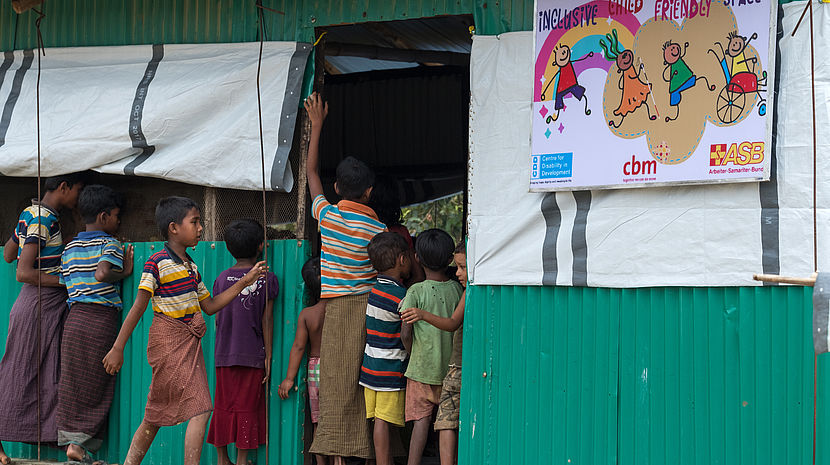New Report on Including Persons with Disabilities in Humanitarian Action

Children look in on the Centre for Disability in Development (CDD)/CBM inclusive child friendly space in the Rohingya refugee camps in Balukhali, Cox's Bazar district, Bangladesh on August 1, 2018.
©CBM/Hayduk
On December 3rd, CBM, Humanity & Inclusion, and the International Disability Alliance mark the International Day of Persons with Disabilities by releasing a case studies collection in the form of a report called Inclusion of Persons with Disabilities in Humanitarian Action.
This is a collection of 39 examples of field practices inclusive of persons with disabilities in humanitarian context and disaster risk reduction (DRR), from 20 countries of intervention. Published right after the launch of the IASC Guidelines on Inclusion of Persons with Disabilities in Humanitarian Action, this report aims to support their uptake and promote learning by example.
The new report shows that deliberate and proactive action is required to ensure that persons with disabilities from all constituencies are systematically included and meaningfully participate in DRR and humanitarian preparedness, response and recovery. It draws lessons from field practices, but does not provide technical guidance. The newly published IASC Guidelines are the reference document to seek in-depth theoretical and technical information.
Inclusive humanitarian action for persons with disabilities is an emerging area for most actors implementing the UN Convention on the Rights of Persons with Disabilities (CRPD), engaged in commitments taken at the 2016 World Humanitarian Summit and who have endorsed the Charter on Inclusion of Persons with Disabilities in Humanitarian Action. It is also an evolving concept, and it is therefore essential that evidence be gathered to provide replicable examples of good practices from the field to support the systemic change required by humanitarian stakeholders.
The case studies included in the report focus on:
- Inclusive disaster risk reduction and preparedness, showing how DRR and preparedness benefit by ensuring access and participation to persons with disabilities and organizations of persons with disabilities (OPDs).
- Collecting and using disability disaggregated data for assessments and programming, such as through participatory research and rapid assessment studies on the situation of persons with disabilities during and after disasters.
- Participation of persons with disabilities and their representative organizations in humanitarian response and recovery, including projects led by OPDs, or done in collaboration between NGOs and OPDs.
- Removing barriers to access humanitarian assistance and protection though projects in which persons with disabilities and OPDs are at the center of assessing and addressing those barriers, and examples of humanitarian actors seeking external technical support.
- Influencing coordination mechanisms and resource mobilization, such as through disability-focused coordination mechanisms, as well as by influencing national Humanitarian Response Plans and pooled funding.
The publication has been supported by the Australian Government and the European Union Humanitarian Aid.